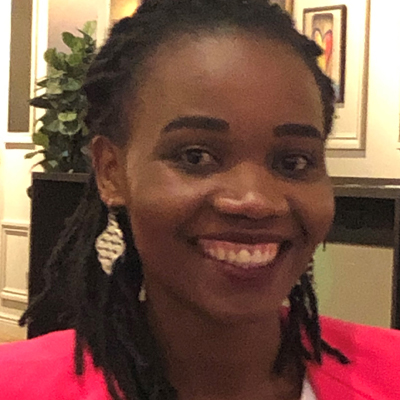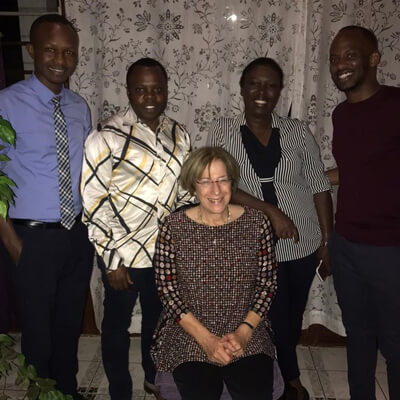Even as a young girl attending primary school in rural Rwanda, M. C. Sage Ishimwe, M.B.B.S, M.P.H., already knew that she wanted to help her community become healthy. She began medical school in 2011 at the University of Rwanda College of Medicine & Health Sciences and soon joined the Rwanda Village Community Promoters, a student organization dedicated to improving health standards in underserved communities.

Dr. Ishimwe quickly noticed that many of her patients presented with noncommunicable diseases, like Type 2 Diabetes (T2D). Similar to many other countries in Africa, Rwanda is experiencing an alarming increase in the prevalence of T2D. The International Federation of Diabetes predicts that from 2019 to 2045, there will be an increase from 19 million to 47 million people living with T2D throughout Africa1. This is the highest anticipated increase in the world.
“This fact keeps increasing my desire to do research and find a way to help,” Dr. Ishimwe says. When she graduated from medical school in 2017, she worked in both rural and urban hospitals. “As a medical doctor, I’m only helping one person at a time and I can’t advocate for an entire group at once. I kept on thinking, that’s not enough to help the entire community.”
Dr. Ishimwe next pursued her Master’s in Public Health to develop her research skills and published an analysis on preventable hypoxic ischemic encephalopathy in babies born at Kacyiru Hospital in Rwanda2. She next applied and was appointed as a Research Faculty with the University of Global Health Equity based in Rwanda. Her new position included a one-year clinical research fellowship with the NIH-Rwandan Health Program.
An International Effort to Understanding Diabetes in Africa: Five Years In
The NIH-Rwanda Health Program is an international program, founded by Dr. Anne Sumner, senior investigator at the National Institute of Diabetes and Digestive and Kidney Diseases (NIDDK), and with the critical support of NIMHD Director Dr. Eliseo J. Pérez-Stable, who in 2016 immediately recognized the potential value and contributions this program could make. The program has grown into an international-inter-institute collaboration between NIMHD with Dr. Anna María Nápoles as Scientific Director in support, NIDDK with Dr. Sumner in the lead, and the key Rwandan partner of Dr. Agnes Binagwaho, Vice Chancellor of the University of Global Health Equity. The program is designed to support the next generation of clinical researchers in Rwanda. Dr. Ishimwe is the program’s fifth fellow.
“One of the goals of the program is to turn trainees into independent scientists, and ultimately into leaders in public health,” Dr. Sumner says. “We encourage the fellows to develop important new questions and acquire the skills to address them.”
Other goals of the program are to encourage research capacity building through expansion of trained clinician scientists. “Supporting this program helps build the needed infrastructure to combat global health inequities,” Dr. Pérez-Stable says. “The Rwandan fellows have also deepened our understanding of how diabetes manifests in African populations, which will hopefully lead to better prevention and control strategies, especially in communities with societal barriers to overcome.”

Under Dr. Sumner’s mentorship over the last five years, the programs first fellow, Dr. Utumatwishima, led projects to study the etiology of T2D in Africans, which is not well understood3. Dr. Kabakambira, the program’s second fellow, found that most Africans with diabetes are not obese and their body mass index (BMI) may not be a useful predictor of diabetes in African populations4. Drs. Mugeni and Hobabagabo, the third and fourth year fellows, respectively, developed improved prediction models for diabetes and identified blood markers for diagnosing diabetes in nonobese Africans5-6.
In July 2020, Dr. Ishimwe began her fellowship, and followed the work of her prior colleagues. A hallmark condition of diabetes is abnormal glucose tolerance (Abnl-GT), often caused by insulin resistance (IR). However, the etiology of IR is only one path to Abnl-GT and T2D. Beta islet cells (β-cells) in the pancreas produce insulin and disruption of this process may also predispose individuals to diabetes, particularly in individuals who are not obese. Dr. Ishimwe wanted to establish the prevalence of β-cell failure in Africans with T2D.
She found that β-cell-failure in Africans with Abnl-GT was nearly twice as common compared with IR. Furthermore, if traditional BMI cutoffs were used to screen for Abnl-GT, Africans with β-cell-failure would be disproportionately underdiagnosed. Her work supports the fact that better screening methods are needed for diverse populations at-risk for diabetes. Her work has been accepted as an abstract at the upcoming annual meeting for the American Diabetes Association and the accompanying manuscript is under peer review.
“Under Dr. Sumner’s mentorship, the fellows flourish and learn how to apply new clinical research skills to ameliorate and prevent health disparities related to T2D in Rwanda,” says Dr. Nápoles. “The benefits of this successful training experience are multiplied when the fellows return to Rwanda, applying and disseminating what they have learned.”
The Future of Diabetes Research in Rwanda
Dr. Ishimwe knows that the cost of diagnosing diabetes is a barrier to many in Rwanda. To address this concern, she spent part of her fellowship comparing different metabolic screening methods that clinicians use to screen for IR and diabetes. She compared the Homeostatic Model Assessment for Insulin Resistance (HOMA-IR) and HOMA of β-cell function (HOMA-B) indices with the Matsuda and Insulin Secretion Indices. All of these tests require blood draws after an oral glucose tolerance test.
“HOMA-IR and HOMA-B screening are inexpensive compared with the Matsuda and Insulin Secretion indices,” she says, “because the HOMA methods only require one blood draw instead of five. This saves funds in areas that are already under resourced and could help screen more patients, faster.” In her study cohort, there was no difference in screening for insulin sensitivity or insulin secretion by method.
These findings could have enormous implications for screening for diabetes in Rwanda. When she returns, Dr. Ishimwe plans to work with the program’s prior fellows and continue to develop the research infrastructure in Rwanda, especially in the rural areas. Her long-term research goals are to determine the prevalence of diabetes in her work area of Butaro and begin a prospective study on glucose tolerance. She would like to use the diagnostic parameters she began exploring while at the NIH and couple that with education on lifestyle change and potentially, medical treatment. Prevention and education are some of the most cost-effective ways to tackle this problem.
At the NIH, the program’s sixth fellow arrives in mid-July, further strengthening this research training pipeline in Rwanda and beyond.
References
- International Diabetes Federation (IDF). IDF Diabetes Atlas 2019: Africa (9th Ed.). Accessed June 16, 2020.
Page updated August 20, 2021
More Information
Learn more about the NIH-Rwandan Health Program

